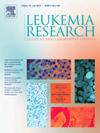A phase 1 trial of ibrutinib and azacitidine for higher risk myelodysplastic syndromes (University of California Hematologic Malignancies Consortium Study 1503)
IF 2.2
4区 医学
Q3 HEMATOLOGY
引用次数: 0
Abstract
Despite the use of hypomethylating agents (HMA), outcomes remain poor for patients with higher-risk myelodysplastic syndromes (HR-MDS). Ibrutinib (IBR) is a Bruton’s Tyrosine Kinase (BTK) inhibitor that can exert anti-myeloblast activity through inhibition of NF-kB signaling. IBR also has immunomodulatory activity through binding to interleukin-2-inducible kinase (ITK). We conducted a multicenter Phase 1b trial (NCT02553941) to evaluate the safety, tolerability, and preliminary efficacy of the combination of IBR and azacitidine (AZA) in patients with HR-MDS. Patients received standard AZA in combination with IBR at two dose levels (DL), 420 mg (DL1) and 560 mg (DL2). Twenty-one patients were enrolled, including 17 with high- or very high-risk disease and six with prior HMA therapy. No dose-limiting toxicities were observed in the dose escalation cohorts. The most common grade 3 or higher adverse events included thrombocytopenia, neutropenia, anemia, and febrile neutropenia. Bleeding events occurred in 14 patients (67 %), with a grade 3 event in one patient. The overall response rate was 48 %, including 3 (14 %) complete remissions (CR) and 4 (19 %) marrow CR. Responses were seen in patients with TP53 mutations or deletions. CD34 positive bone marrow mononuclear cells (BMMC) BTK and peripheral blood MC (PBMC) ITK occupancy by IBR demonstrated on-target activity in relevant target cells. In patients with HR-MDS, the combination of IBR and AZA is safe, tolerable, and active, including responses in patients with TP53 aberrations and with prior HMA therapy. Further study in a larger, randomized trial is necessary to assess efficacy of this regimen for patients with HR-MDS.
伊鲁替尼和阿扎胞苷治疗高危骨髓增生异常综合征的1期试验(加州大学血液恶性肿瘤联盟研究1503)
尽管使用了低甲基化药物(HMA),但高风险骨髓增生异常综合征(HR-MDS)患者的预后仍然很差。Ibrutinib (IBR)是一种布鲁顿酪氨酸激酶(BTK)抑制剂,可通过抑制NF-kB信号传导发挥抗成髓细胞活性。IBR还通过与白细胞介素2诱导激酶(interleukin-2-inducible kinase, ITK)结合而具有免疫调节活性。我们进行了一项多中心1b期试验(NCT02553941),以评估IBR和阿扎胞苷(AZA)联合治疗HR-MDS患者的安全性、耐受性和初步疗效。患者接受标准AZA联合IBR两种剂量水平(DL), 420 mg (DL1)和560 mg (DL2)。21例患者入组,其中17例患有高风险或高危疾病,6例既往接受HMA治疗。在剂量递增组中未观察到剂量限制性毒性。最常见的3级或以上不良事件包括血小板减少、中性粒细胞减少、贫血和发热性中性粒细胞减少。14例患者发生出血事件(67% %),1例患者发生3级出血事件。总有效率为48 %,包括3例(14 %)完全缓解(CR)和4例(19 %)骨髓CR。TP53突变或缺失患者均有反应。CD34阳性骨髓单核细胞(BMMC) BTK和外周血单核细胞(PBMC) ITK被IBR占用在相关靶细胞中显示出靶向活性。在HR-MDS患者中,IBR和AZA联合使用是安全、耐受和有效的,包括TP53异常患者和先前接受HMA治疗的患者。需要在更大的随机试验中进一步研究,以评估该方案对HR-MDS患者的疗效。
本文章由计算机程序翻译,如有差异,请以英文原文为准。
求助全文
约1分钟内获得全文
求助全文
来源期刊

Leukemia research
医学-血液学
CiteScore
4.00
自引率
3.70%
发文量
259
审稿时长
1 months
期刊介绍:
Leukemia Research an international journal which brings comprehensive and current information to all health care professionals involved in basic and applied clinical research in hematological malignancies. The editors encourage the submission of articles relevant to hematological malignancies. The Journal scope includes reporting studies of cellular and molecular biology, genetics, immunology, epidemiology, clinical evaluation, and therapy of these diseases.
 求助内容:
求助内容: 应助结果提醒方式:
应助结果提醒方式:


